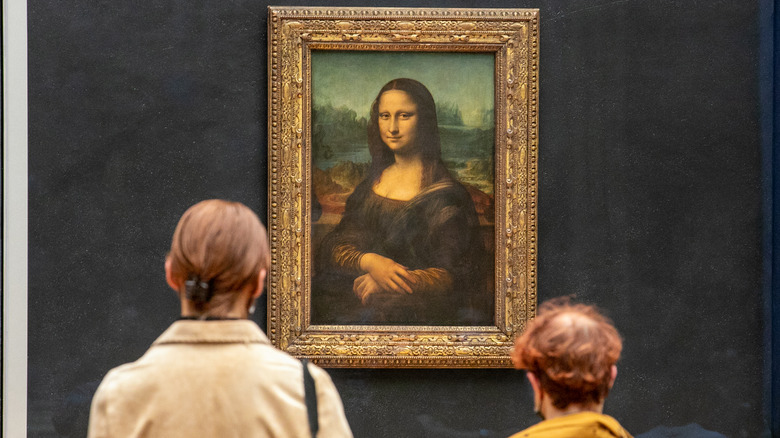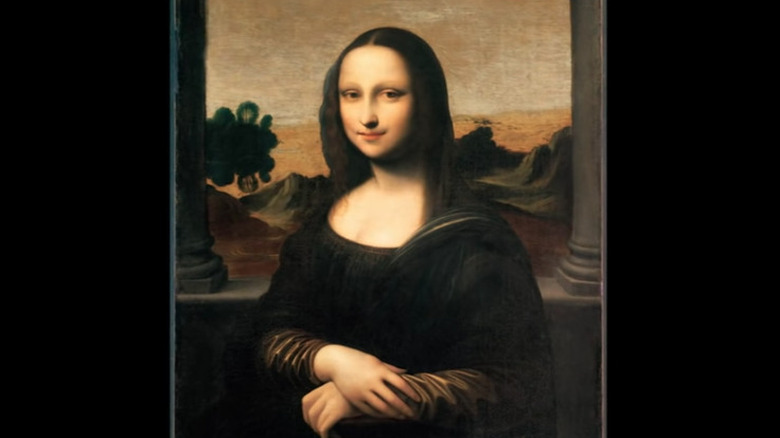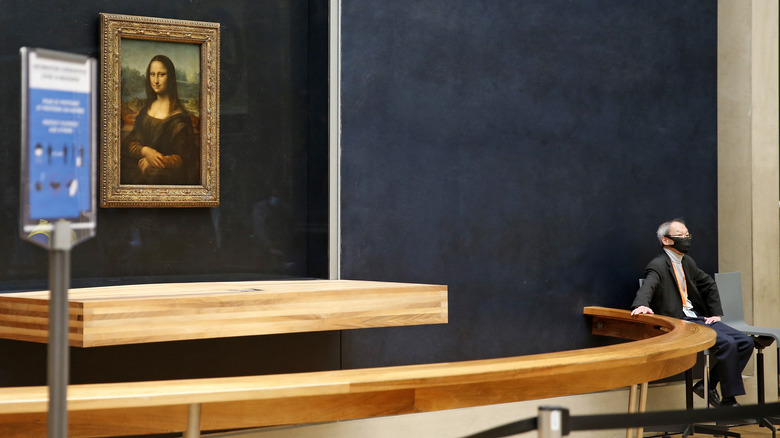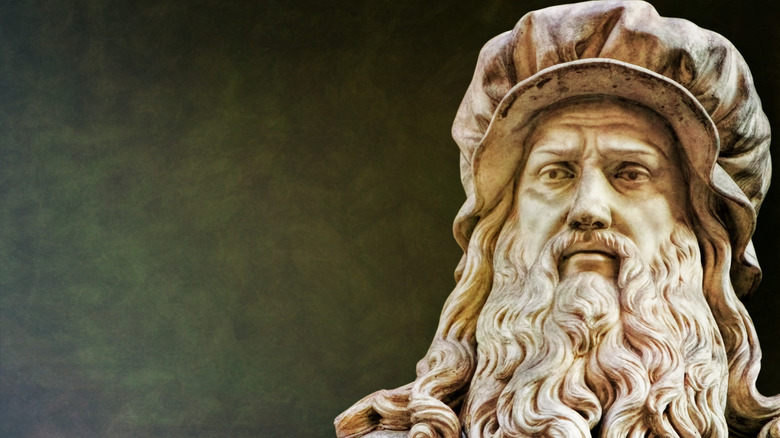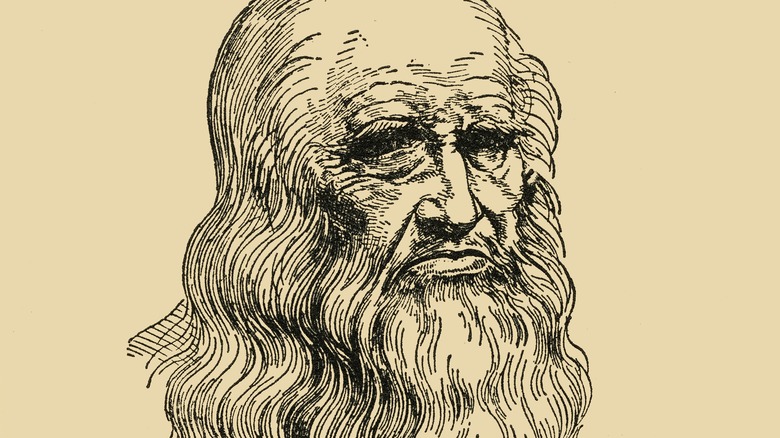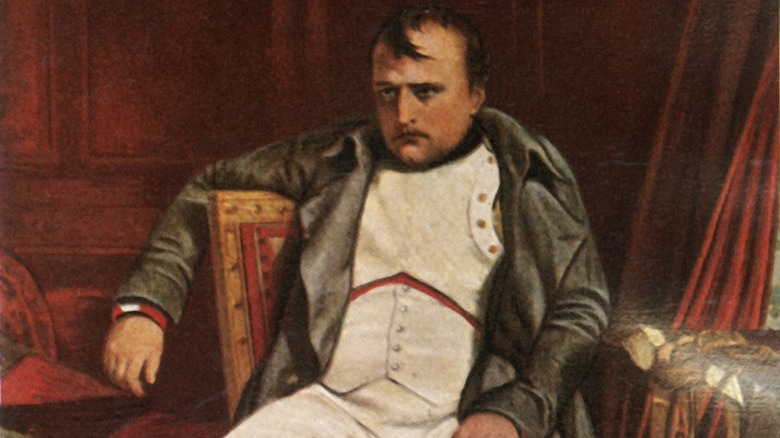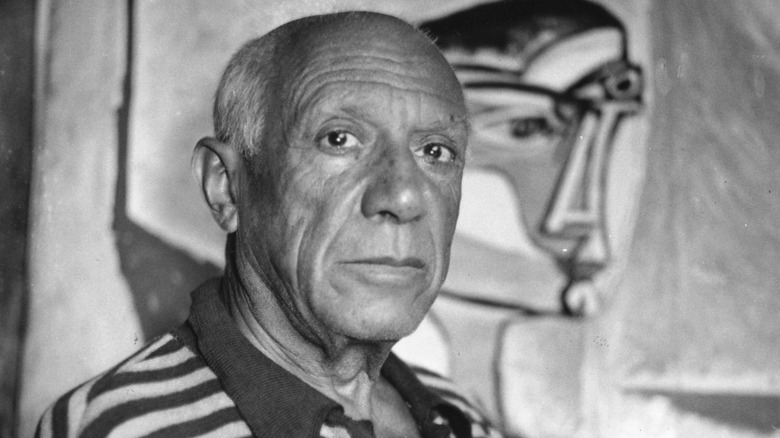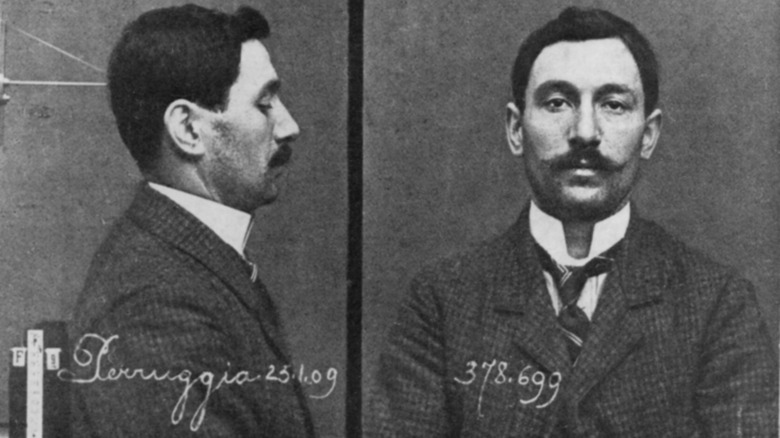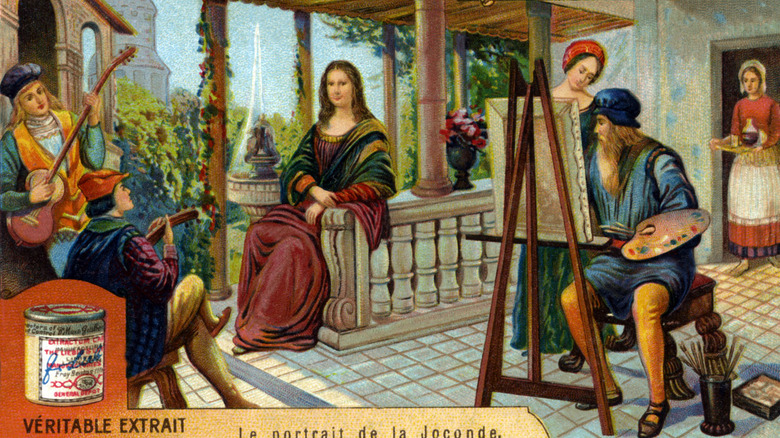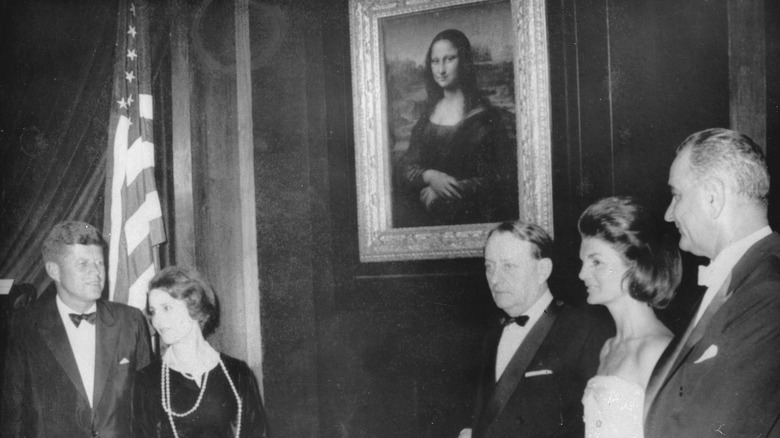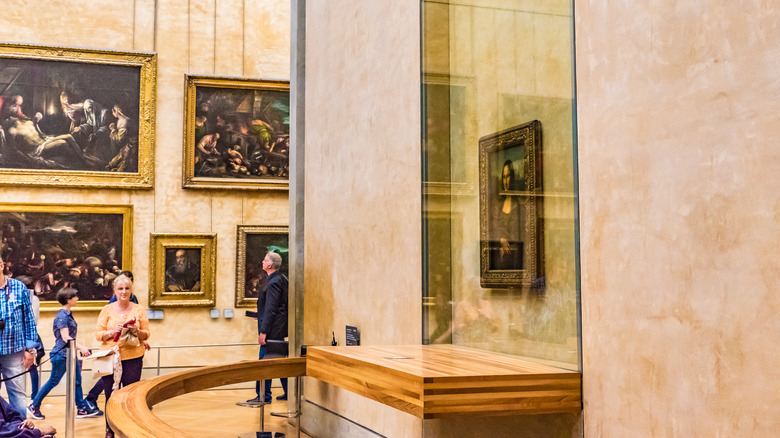The Untold Truth Of The Mona Lisa
Mona Lisa's eyes famously appear to be holding back a secret. Make that several. In her 500-year existence, the "Mona Lisa" has been beheld by kings and emperors, celebrities, lustful men, and angry activists. She has been treasured, adored, reviled, and attacked with cake. That most recent confection-filled assault on the "Mona Lisa" has brought light to the amount of security the Louvre's most famous painting demands and what holes remain. With each new attack — it has been subjected to at least five — the Louvre has upped its security and even once gave the painting its own gallery, per ART News.
Leonardo da Vinci began the painting in 1503 and is widely thought to have used Italian mother and housewife Lisa Gherardini as a model. She's everyone's best guess, although there are no records of a commission. The "Mona Lisa" has become famous for various reasons. One must to be attributed to Leonardo's skills as a painter; the "Mona Lisa" demonstrates his pioneering sfumato technique, per Britannica. Mona Lisa's smile was also revolutionary in a time when Renaissance painters rarely made their subjects smile, per CNN. But perhaps the largest reason the "Mona Lisa" is a household name is because she was stolen. Yes, like any celebrity fame that began with a scandal, the infamous 1911 theft made Mona Lisa legendary.
The 'Mona Lisa' may have been unfinished
To the untrained eye, the "Mona Lisa" appears complete. More than complete — it's a masterpiece, in fact. But the consensus among historians is that Leonardo da Vinci intended to add more to it, but never had the chance to finish. He didn't paint in the last five years of his life, and the "Mona Lisa," among others, was left incomplete. Naturally, people have attempted to attribute specific reasons as to why he didn't complete it. In 2005, historian Alessandro Vezzosi discovered a painting that depicted Leonardo with his arm in some sort of sling, per The Guardian. Vezzosi believed the right side of his body was paralyzed. Although Leonardo was usually left-handed, he painted with his right.
People have assumed a stroke caused his paralysis, but in 2009, doctors announced they believed Leonardo suffered nerve damage from a fall during a fainting spell. The doctors thought a stroke was unlikely since he didn't have any cognitive problems — a symptom common among stroke victims. The researchers derived their conclusion from examining two paintings of Leonardo himself and two contemporary documents that confirmed his paralysis, according to Forbes.
It may have been a sequel to an earlier work
Before the "Mona Lisa," there was the "Isleworth Mona Lisa." It has most of the same details — pencil-thin eyebrows and all — but with a noticeably younger face and a different landscape in the back. Experts have known of the "Isleworth" since shortly before World War I, when it was discovered in an old manor in Somerset, England. Some historians believe that the subject of the painting was Lisa Gherardini 10 years before her more famous depiction. A 2012 research conference, called the Mona Lisa Foundation, dedicated to de-mystifying the painting, agreed that it was created by Leonardo himself in an early iteration of the "Mona Lisa."
However, many prominent scholars are unsure of its origins and remain hesitant that Leonardo was its creator. For one, the "Isleworth" was painted on canvas, while the later "Mona Lisa" was painted on wood. One expert, Oxford professor Martin Kemp, believes the painting contains none of Leonardo's techniques. He and another scholar, expert Luke Syson of New York's Metropolitan Museum of Art, see the painting as a poor imitation that was made after Leonardo's original, per BBC.
It was painted on wood
Unlike the canvas commonly used today, Leonardo da Vinci used thin, poplar wood panels. Before the 16th century, wood was the go-to support material for painters, and before 1470, canvas was virtually unused, per The Mona Lisa Foundation. But the once-popular choice has led to problems some 500 years later. In 2004, workers at the Louvre announced that the wood underneath the Mona Lisa started to concave, causing the painting to warp. Wood absorbs water like a sponge, causing it to change shape with changes in humidity. This is the reason why the Mona Lisa was already temperature-controlled, leading experts to blame the surrounding light or other undetected changes in the environment, per The Guardian.
The unintended damage to the painting led experts to reconsider museum preservation practices. In fact, subsequent research found that paintings are more resilient to humidity than most museums give them credit for. Additionally, the "Mona Lisa" was braced with wood battens, perpendicular sticks attached to its back, which have been found to weaken paintings and induce cracking. Perhaps most importantly, the space between the painting and the wall isn't temperature-controlled and might've led to condensation. After the Louvre moved the "Mona Lisa" away from the wall, an expert noticed that the warping became less conspicuous, per The New York Times.
Leonardo never gave the painting to its patron
Leonardo da Vinci decided to keep the painting for himself, and who can blame him? It's widely believed that the "Mona Lisa" was commissioned in 1503 by Lisa's husband, Francesco del Giocondo, a wealthy merchant, per Encyclopedia. This was documented in Giorgio Vasari's biography of Leonardo, which Vasari wrote 31 years after the inventor's death, per PBS. It's evident, however, that Francesco and his wife never received it. Leonardo worked on the "Mona Lisa" for four years and eventually began other paintings. However, he kept adding to it over the years and even brought it with him to France, where he was sponsored by Francois I of France, per BBC and PBS. The king then acquired it for 4,000 gold écus. Except for the time it was stolen from the Louvre 400 years later, it has stayed in France ever since.
It's unclear why the "Mona Lisa" was never given to its model. Some theories posit that the painting never belonged to a single patron. Instead, Mona Lisa was a composite of several women to form Leonardo's ideal woman. Another theory speculates that Mona Lisa originated in Leonardo's imagination, per PBS.
Some historians believe it was a self-portrait
Maybe the reason why Lisa del Giocondo never received the painting was because she wasn't the model. One theory suggests that Mona Lisa is actually Leonardo da Vinci in drag. In 2010, researchers set out to test the self-portrait theory by seeking approval for the exhumation of the painter's remains. They planned to carbon date and DNA-test the remains to ensure the grave is Leonardo's, per NBC. Experts aren't sure if the grave at the Saint Hubert Chapel in the Loire Valley of France is his, since his original resting place at Chateau Amboise was destroyed during the French Revolution. The new grave marker is considered symbolic.
After proving the remains were Leonardo's, the researchers then planned to create a facial reconstruction from his skull and compare it to the Mona Lisa. It seems the project has since been abandoned, but one researcher managed to prove the claim without digging up old graves. In 2007, Lillian Schwartz publicized a computer study that found that known portraits of Leonardo da Vinci "superimpose perfectly" with the "Mona Lisa," according to Italy Magazine. Although the self-portrait idea remains only a theory, one couldn't put it past someone like Leonardo, who was known as a mischievous and cheeky fellow. He loved puzzles, symbols, and hidden things (per ABC News), and what bolder thing to hide than his own face?
Lots of men, including Napoleon, have fallen for her
La Gioconda has inexplicably broken some hearts over the years, especially men's. According to Dianne Hales' "Mona Lisa: A Life Discovered," men in the 19th century were so infatuated with and romantically inspired by the painting that they left flowers, poems, and love notes at the Louvre. In 1852, artist Luc Maspero flung himself from the fourth-floor window of a Paris hotel, leaving behind the note: "For years I have grappled desperately with her smile. I prefer to die," per New York Post. Similarly, in 1910, a man shot himself to death in front of the painting, according to Time. Even the thief who famously stole the painting in 1911, Vincenzo Peruggia, blamed his crime on Mona Lisa's supposed seduction of him.
The most famous admirer was Napoleon Bonaparte. Three years after the French Revolution, before which the "Mona Lisa” dwelled in royal palaces, Bonaparte took the painting for himself and hung it up in his bedroom. He treasured the painting and lovingly called it "Madame Lisa." It may have inspired his romance with a woman named Teresa Guadagni, who was in fact Mona Lisa's descendent, per New York Post.
Picasso was suspected of her theft
When Pablo Picasso was 29 years old, he was reluctantly dragged into the debacle that was the greatest art heist of the 20th century. Or, at least, he was suspected of the crime. In 1911, Picasso was a Bohemian artist, living as a foreigner in Paris. When the "Mona Lisa" was stolen on August 12, the Paris-Journal offered an award for information on the theft. Noted con man Honoré Joseph Géry contacted the paper and admitted to stealing a statue from the Louvre years earlier while implicating a former employer, Guillaume Apollinaire. Unfortunately for Picasso, he and Apollinaire were colleagues and ran in the same circles. When investigators pressured him for answers, Apollinaire admitted selling the stolen Iberian sculptures to Picasso, per Time.
Picasso was arrested and interrogated before a magistrate. Fearing deportation and brought to tears, Picasso denied knowing Apollinaire or about the crime. In later years, Picasso said he was ashamed of his lie in court and could still remember the betrayed look on Apollinaire's face. In reality, Picasso may have even encouraged Apollinaire to steal the Roman-era sculptures, intending to use them in his "Les Demoiselles d'Avignon." Luckily for the two friends, the judge realized their crimes were separate from the "Mona Lisa" theft, and they were acquitted, per Mental Floss.
France mourned her loss as England did for Princess Diana
In the early hours of an August morning in 1911, former Louvre carpenter Vincenzo Peruggia plucked the "Mona Lisa” from a frame that he helped build. When he was arrested in 1913, Peruggia said he committed the crime in order to return the painting to its rightful place in Italy. But for two grueling years, France had no "Mona Lisa." Outside the country, many had never heard of the painting. But inside Paris, people struggled to adapt to its absence. The Louvre was closed for nine days, and the French borders were shut. Departing ships and trains were inspected. When the museum opened up again, people lined up just to stare at the painting's empty frame. Fun fact: Among them was Franz Kafka, per Time.
According to Dianne Hales in "Mona Lisa: A Life Discovered," France's mourning felt personal (via New York Post). The "Mona Lisa" might as well have been a living, breathing human. People left flowers and notes at the painting's remains, and according to the New York Times, the mourning was comparable to that of England's after Princess Diana's death. The adoration for the "Mona Lisa" was evident in the way France responded to its theft and its return. The director of the Louvre was fired, anger simmered at the lack of security, and women's beauty trends took on the "La Joconde" look, which mimicked Mona Lisa's golden complexion, per New York Post.
The painting cannot be sold
As the COVID pandemic ravaged the French economy, one tech CEO had a novel idea to make his country money: Sell the "Mona Lisa." In May 2020, Fabernovel founder Stephane Distinguin proposed selling France's most treasured artwork for at least €50 billion. He considered his plan a sensible one, considering the dire economic circumstances, and his suggested price tag, reasonable. In a considerably different alternative, Distinguin described a scenario in which the Louvre could keep the painting, but it would be "tokenized" and sold through cryptocurrency, according to The Independent.
In a similar but bizarre instance, a 2021 Change.org petition urged Jeff Bezos to purchase the painting and eat it. It was a joke, of course, but Bezos, whose net worth was $200 billion at the time, could actually pull it off. Eating the painting would be up to him, however. The problem with both Distinguin's and the petition's proposals is that the "Mona Lisa" is not for sale and never will be. Under the French Heritage Code, the "Mona Lisa" is considered a national treasure, and so it's protected from sale, according to The New York Times.
Mona Lisa might have been pregnant
Lisa del Giocondo gave birth to six children (per The Mona Lisa Foundation), and Leonardo da Vinci might've painted her after the birth of one of those children. When researchers made 3D images of the "Mona Lisa," they found evidence that the scarf over her shoulder is transparent. This type of gauzy veil was called a guarnello and was worn by women during the Italian Renaissance when they were pregnant. It's tough to make out in the painting's current state, which has darkened over time. Sandro Botticelli's contemporary "Portrait of a Lady ” also contains a guarnello, per NBC News.
Historians believe that the painting was commissioned by Lisa's husband, Francesco, to celebrate the birth of his second son. Since Leonardo began the painting in 1503, that would've matched with the birth of their son, Andrea, who was born in 1502, per The Mona Lisa Foundation. The 3D scans also revealed Mona Lisa's real hairstyle. Most of her hair is tied up in a chignon, and her head is covered in a veil, per NBC News.
It has the priciest insurance valuation in history
When the "Mona Lisa" went out to see the world in 1962, it received the highest known insurance valuation for a painting, according to Guinness World Records. It was valued at $100 million, which translates to about $957 million in 2022 dollars, per US Inflation Calculator. It would have been worth receiving; the Mona Lisa's tour included a White House event before it was shipped off to New York for an exhibit, all occurring over the course of four months. But like a lot of average renters, the painting's handlers opted out of purchasing insurance and instead invested more in security.
It isn't unusual for the "Mona Lisa" to risk the insurance. According to Georg Freiherr von Gumppenberg of Allianz, as the painting sits in the museum, it forgoes insurance. Additionally, the Louvre is less likely to loan out its most famous painting than it did in the past. Insurance isn't a relevant factor when it comes to a national treasure like the "Mona Lisa." If it were to get damaged, the whole nation would be liable, according to Gumppenberg. Raphael's Sistine Madonna, which resides in Dresden, works on a similar framework and doesn't use insurance, per Allianz.
It has been attacked various times
Even after it was stolen in 1911, the "Mona Lisa" continues to see some things. In 1956, two attacks were attempted against the painting. A man tried to tear the painting with a razor blade but failed. Later in the year, a man remembered he had a rock in his pocket as he peered at the "Mona Lisa" and decided to throw it. Luckily, the painting's glass protected it from much of the onslaught, although it did chip off a speck of paint. The painting came out of exhibition for a few days, and conservators successfully restored it. In 1974, the "Mona Lisa" visited Tokyo at the National Museum. Controversy surrounded the Museum's reluctance to accommodate disabled visitors and provide them with access. An activist attempted to spray paint the "Mona Lisa" in red, successfully landing around 30 droplets. The painting was restored, and the museum dedicated a day to disabled visitors.
In 2009, a Russian woman denied French citizenship brought a teacup to the Louvre, intent on smashing it against the painting. Luckily, the glass protected it from damage. But as a result, the Louvre gave the painting more security, including its own gallery and a newer glass. Finally, this past year, a man dressed up as a woman in a wheelchair smeared cake over the painting's glass in protest of climate change. Thankfully, the "Mona Lisa" went unharmed, per ART News.
